Ramon’s Report #1
Bioregionalism Education
Summer Session, 2009
May 6 & 8, 2009 – English
(Click here for Spanish/Español)
Photos below
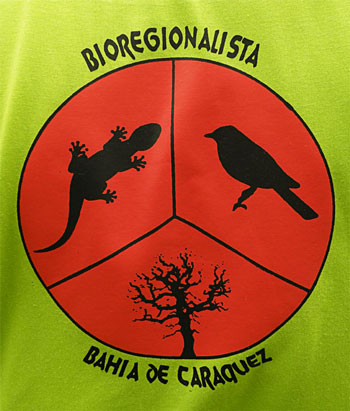
We started a new school year of Bioregional Education. This time there are three educational institutions: Colegio Vicente Hurtado, with Fabiola Coello as the teacher and Lissette Moncayo as assistant; Colegio Fanny de Baird, with Paola Divito as the teacher and Roberto Rodriguez as the assistant; and Colegio Javier Rodriguez, with myself as teacher and Raisa Torres as my assistant.
Once we were all present, we sat in a circle, and passed out the workbooks, pencils, erasers and T-shirts. Afterwards, we played the traffic light game to gain a sense of being a group together. It consists of standing up, sitting down and changing places according to which color is called out.
When the game was finished, each student read the introduction to the Bioregionalism textbook and made an analysis. Evelyn commented that after having read the introduction she realized that because she uses the internet at home, she no longer leaves her house except to go to school. Gonzalo concluded that the environment is very important because it gives us everything. After the period of reflection, I told them that it is important to enjoy what the environment has to offer. I explained that on our way from our homes to other places we can see and find many things that we will not enjoy if we only surround ourselves with technology.
We talked about the meaning of a bioregion, most importantly the main characteristics of soil, watershed, climate, flora and fauna, and landscape. The students asked what kind of soil we have. I explained that the majority of our soil is composed of clay but since we are in a coastal region, we can find much sandy soil as well. Ivana commented that anything she plants in her backyard grows. I told her that it must be humiferous, which means it is a soil rich in nutrients. We conversed about what happens in nature during each of the two seasons of the equatorial year; summer and winter. The students did not know what a watershed is. I told them that watersheds develop from the runoff of mountains into valleys which form rivers like Rio Chone, our estuary.
For our first field trip we walked to Playa Gringa, where I was able to point out several watersheds, the estuary and its vegetation, made up of mangroves. I explained that right now the forest is green, however, in the months of October and November most trees lose their leaves. On our walk we observed two kinds of birds: lincheros and aguilars. We noticed the flowers of the Ceibos, and a native tree called Bototillo that is beginning to lose its leaves. We arrived at Playa Gringa beach and the students played in the water a bit before our return home.
– Ramon
Translated by Paola Divita
Note: Click on photos for larger images
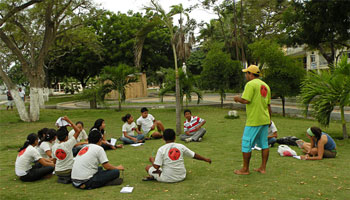
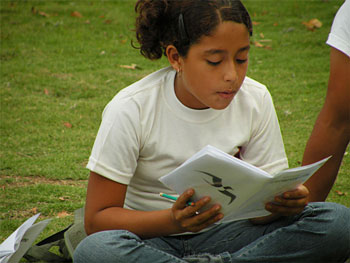
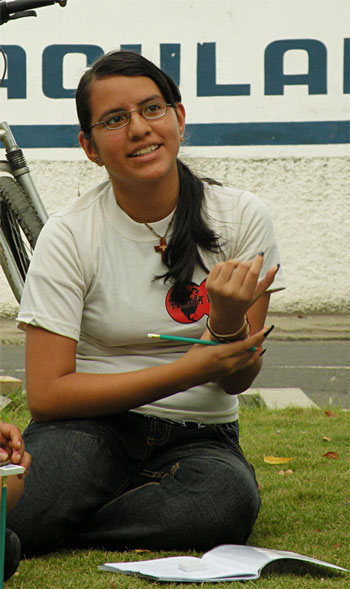
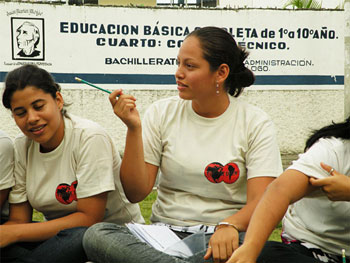
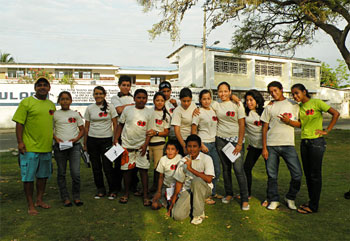

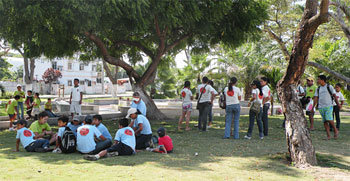
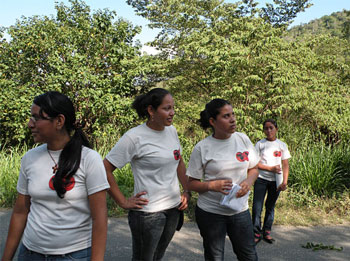

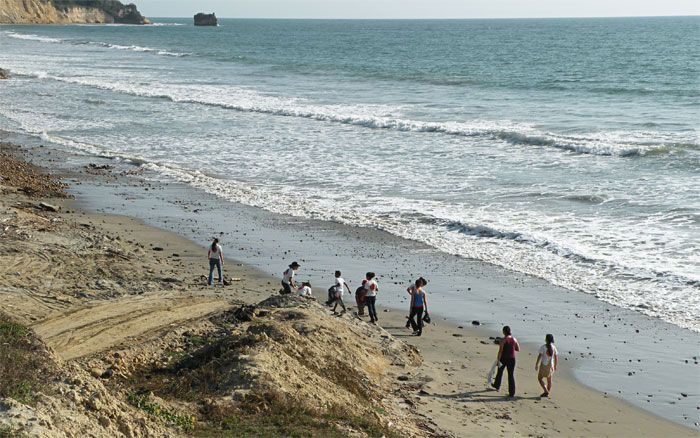
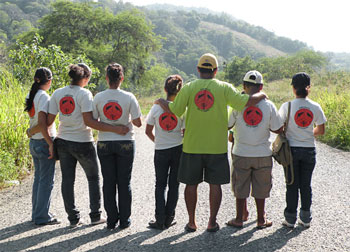
May 6 & 8, 2009 – Spanish/Español
Comenzamos un nuevo año de bioregionalismo, pero esta vez con tres instituciones educativas, el Colegio Vicente Hurtado, con Fabiola Coello como profesora y Lissette Moncayo como asistente, el Colegio Fanny de Baird con Paola Divito como profesora y Roberto Rodríguez como asistente y el Colegio Javier Rodríguez con su asistente Raisa Torres y el Lcdo. Ramón Cedeño como profesor guía.
Una vez que todos estábamos presentes nos sentamos en un círculo e hicimos la entrega de los libros, lápices, borradores y camisetas. Después hicimos la dinámica del semáforo que consiste en levantarse, sentarse y cambiarse de lugar de acuerdo al color que se nombrara.
Una vez terminada la dinámica, cada uno de los chicos leyó la introducción e hizo su respectivo análisis. Evelyn dijo que después de haber leído se dio cuenta que ella por utilizar el internet ya no sale de su casa, que apenas sale del colegio llega y se sienta en la computadora. Gonzalo dijo que es muy importante el medio ambiente porque nos da todo. Después de la reflexión, les dije que es muy importante disfrutar de las cosas que nos brinda el medio ambiente, que en nuestro recorrido de nuestras casas a algún lugar vamos a ver y a encontrarnos con muchas cosas que no las podemos disfrutar si solo vivimos con la tecnología.
Conversamos sobre que es una bioregion, cuáles son sus características; que una bioregion está formada por: suelo, cuenca, clima, flora y fauna y paisaje. Los chicos preguntaron qué clase de suelo poseemos. Les dije que la mayoría de nuestro suelo es arcilloso pero que en las zonas costeras tenemos arenosos. Ivana dijo que en el tipo de suelo que tiene en el patio de su casa todo lo que siembra crece, a lo que le respondí que era un suelo humifero, es decir un suelo rico en nutrientes. Hablamos sobre lo que pasa en la naturaleza durante las dos estaciones que poseemos; invierno y verano. Me preguntaron que es una cuenca, y les dije que una cuenca se forma con la unión de varias montañas y estas forman ríos que dan origen una gran cuenca como la del Rio Chone, nuestro estuario.
El viernes fuimos caminando hasta playa gringa, donde les mostré varias cuencas, el estuario y su vegetación de manglares. Les conté que ahora el bosque esta verde pero que en octubre y noviembre pierden sus hojas. En nuestro recorrido observamos varios lincheros y dos águilas. También observamos la floración de los ceibos y la pérdida de las hojas de un árbol endémico como el Bototillo. Llegamos a playa gringa y los chicos se bañaron antes de regresar a casa.
-Ramon

Thank you for your sharing. I am worried that I lack creative ideas. It is your article that makes me full of hope. Thank you. But, I have a question, can you help me?
Can you be more specific about the content of your article? After reading it, I still have some doubts. Hope you can help me.
Your article helped me a lot, is there any more related content? Thanks!
Your point of view caught my eye and was very interesting. Thanks. I have a question for you. binance register
Your article helped me a lot, is there any more related content? Thanks!